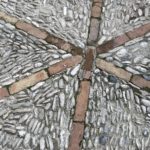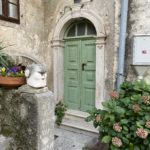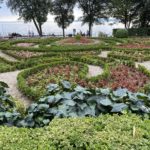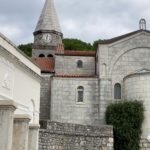Jaboticabal After breakfast this morning, we traveled up the hill to Moscenice, a mountain top town which is one of the oldest settlements in the region. Â Our guide here was Vensa, a local resident, who runs the museum here. She was easy to find – bright red hair! The village was enclosed by a stone wall, sheltering small stone houses and narrow streets, sitting about 170 meters above the Adriatic Sea. It has about 100 residents and everybody knows everybody – and their business! In the 17th century, the Jesuits took ownership of the city and they maintained control until the last half of the 18th century. After a brief stint as part of Napoleon’s provinces, it became part of the Austrian Empire until the end of WWI.
St Andrew’s Church is in the center of the town. Â A small church was built there in the 8th century (only the tower and the wall under the choir with four columns remain today). The new church was added on between 1200 and 1300 AD. The central nave was heightened in 1640, and the two lateral aisles were added in 1785 and 1795. The central altar dates from the 18th century and its five marble statues were sculpted by Jacopo Contieri. One represents St. Ignatius of Loyola, who founded the Jesuits. The pulpit dates to 1791.
We left the church and spent time at the overlook taking in the view, before we visited the olive oil press that is part of the museum. Vensa treated us to a taste of lemon brandy (sort of a bitter limoncello) and honey brandy. Â She explained the process of cold pressing extra virgin olive oil, and the subsequent pressings yielding lesser quality olive oil.
We were able to continue exploring the narrow, winding “streets” and staircases and even found the narrowest street in the world. Â We said goodbye to Vensa and moved on back to Opatija, where Inez was waiting, in another lovely costume, to show us around her husband’s hometown.
Our walking tour enabled us to  view Opatija’s stately villas, seaside promenade, and lovely gardens. We learned that Opatija was the vacation spot of choice for wealthy Viennese during the height of the Austro-Hungarian Empire, which resulted. in the gorgeous villas, now either hotels or divided into apartments. We strolled Park Angelina, next to Villa Angelina, built by a nobleman from Rijeka, Iginio Scarpa in 1844. When Iginio entertained guests from around the world, he did not ask them to pay for lodging but asked them to bring plants or trees from around the world – ultimately forming the garden park today. The mild climate made this the leading winter health spa, patronized by the Austrian royal family and upper class from all over the Hapsburg Empire.  The major attraction is the promenade extending some 7.5 miles along  the seaside.
We lunched at a seaside restaurant, squid and seafood soup accompanied by salads. Kimberly, Mike, and I wandered through town to a chocolate cafe where we purchased a few candies and enjoyed a chocolate coffee: Chocolate Heaven and Nutty Coconut. So sweet it almost hurt your teeth.
Back at the hotel this evening, we attended an insightful discussion about everyday life in Croatia, by a local lecture, Igor. He was delightful. and explained in detail the daily. life in Croatia today: education, salaries, healthcare, GDP, deficit, and retirement.




























